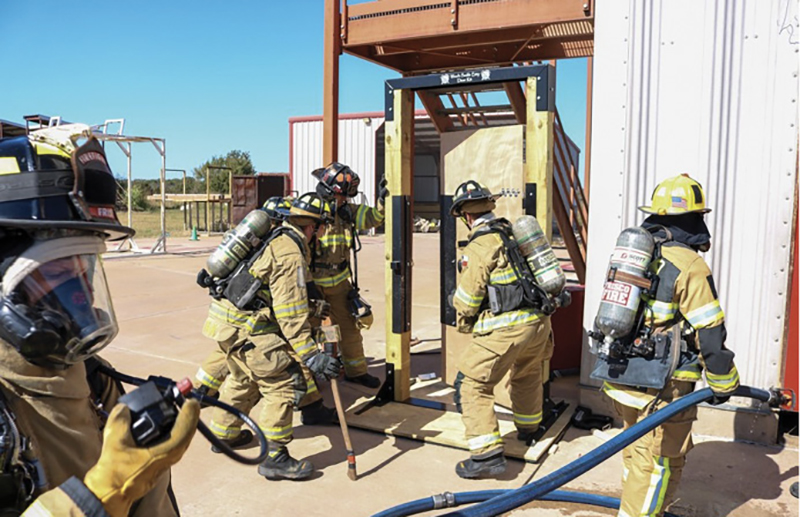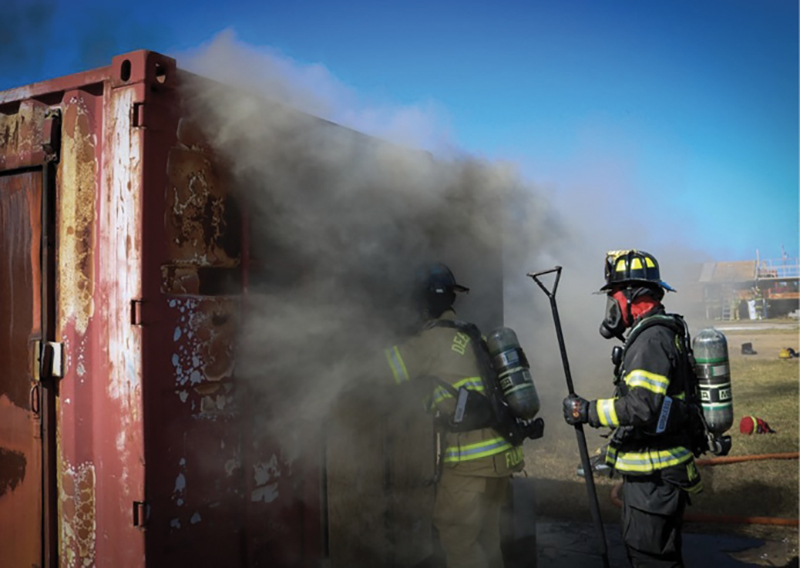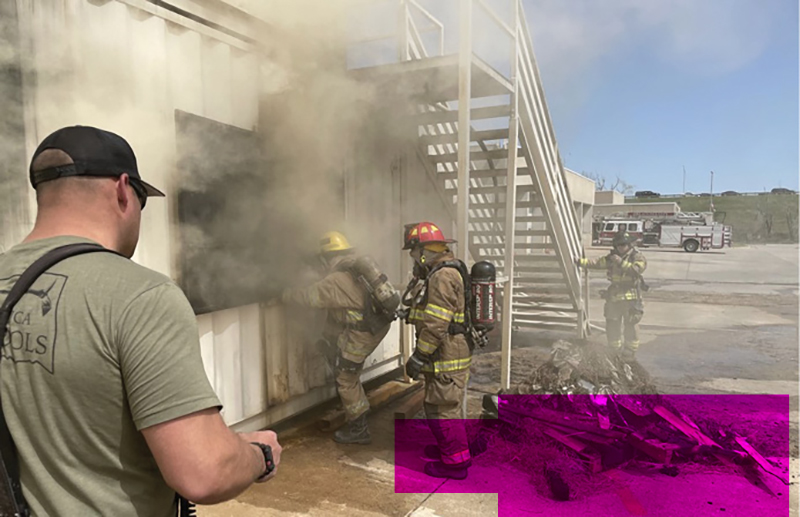A few years ago, the chief of the department I work for set out a challenge for our department; he wanted “live fire training, for every firefighter, every year.” My department has more than 1,000 members and at that time did not have a usable Class A burn facility. Logistically, this goal seemed daunting at first, but it was not impossible; we knew it would be of great value. Read any fire publication in print or online or any of the numerous studies and you’ll see that the American fire service is responding to fewer fires now than 40 years ago. Today’s fires burn hotter and develop much faster than ever before. This means that the American fire service must be more aggressive and sharper with our skills more now than ever before. If fires are burning hotter and faster in today’s world, then we need to be faster, saving precious seconds where we can, and be better at fundamental skills. Seconds add up to minutes, and those minutes save lives.

(1) This small live fire uses pallets and wood shavings. (Photos by author.)
RELATED FIREFIGHTER TRAINING
If we respond to fewer fires now than 40 years ago, one might think surely we are training in fire conditions that bridge this experience gap. Sadly, this does not seem to be the case. A few weeks ago, at a local F.O.O.L.S. training event with live fire Class A hands-on training, the attendees were all asked when they last participated in live fire training. Shockingly, most said they had not done so since their initial firefighter training; for many attendees, that was years ago. After thinking about this for some time and talking to others, I must ask, “Why is it not standard to require that all firefighters attend/conduct live fire training every year?” Below are some common answers and my thoughts on each.
- Class A fire training is not as realistic as the real thing.
- We don’t have the facilities.
- We can’t afford it.
- We have access to a facility but do not have the staff to conduct a training burn safely and train members at the same time.
Not Realistic
I agree; they are not. Although a Class A burn fire is not as realistic as the real thing, that doesn’t mean it is not valuable training. Major League Baseball players still go to batting practice and hit from batting cages. Is this the same thing as trying to hit 90-mph-plus fastballs thrown by a big-league pitcher? Most likely not, but the players see the value in working on their technique and movements. Football quarterback Tom Brady is rumored to still work with a throwing coach in the offseason. This quarterback has thrown more passes than most could ever even imagine; if this is true, then he obviously values the art of building repetitions and practicing fundamentals.
Live fire training for the fire service can easily be our batting cages. Anyone who subscribes to the walk, crawl, run training philosophy should advocate that all skills be performed slowly where you can see at first. Then, perform them again, with increased complexity and challenges like obscured vision and time limits. Finally, practice the skills under live smoke and heat conditions. To truly master our craft, this is a training plan that works and produces better firefighters.
At the F.O.O.L.S. training, we conducted a basic training evolution that we often used for live fire exercises: After completing the briefing and walk-throughs, the fire is set and the torch leaves the building. The fire intensifies and crews are told, “Go!” Crews begin the evolution by forcing a door prop outside the burn building, donning self-contained breathing apparatus (SCBA) face pieces, and advancing hoselines to the fire area through a series of turns and pinch points. Once the fire is fully extinguished, crews perform hydraulic ventilation, overhaul the burnt area, and back out of the structure. Start to finish is usually less than 12 minutes. Open up the building, cool the walls and ceiling, reset, rotate, and repeat. This drill can be made more complex by simultaneously having a second crew perform vent-enter-search (VES) in a space that may or may not have a manikin victim in it. Placing manikin victims in the handline’s stretch path drives the point home that the fire attack crew is responsible for victims found in the stretch path between the door and the inside of the fire room. Search members are responsible for all other areas of the building. Either way, this straightforward evolution focuses on practicing sound fundamentals and getting in those repetitions to build up our skills.
One objective of live fire training is to always recognize and avoid developing bad habits or “training scars” from the live fire training. For example, in the burn prop, many trainees will flow only a small amount of water in short bursts, which can translate into flowing small amounts of water in real fires. This technique stems from the live fire training evolutions in which several firefighters are rotated to the nozzle position for a quick knockdown and each attacks the fire multiple times so that each person “gets time on the nozzle.” This can be a hard habit to break. Often, new firefighters have been told that in an actual fire they are to open the line and keep it open until told otherwise because they were always trained to spray a little and shut the nozzle off; this has built the wrong muscle memory. Training for full extinguishment in every evolution requires more time and effort to build additional fires, but it is worth it.
Training scars can also arise from victim placement. If crews become accustomed to always finding a victim on the left or never expect to encounter victim, they can easily to fall into a false pattern of search or line stretching. An easy fix is to always switch it up; use large or small manikins or none at all. Change the placement—under the window, in the hall, or in a bed. Vary the drill by changing the situation to combat “training scars” created when using manikins in live fire training evolutions.

(2) A firefighter is assigned to a force-the-door prop prior to fire attack before entering the burn building during a live fire evolution.

(3) Firefighters performing VES drills with live fire conditions. This photo was taken after the window had been taken out but before the door had been controlled.
Facilities and Cost
Up to a point, this is a valid concern. True burn buildings can be expensive and financially cost prohibitive. But you can find a way. In Oklahoma, a few departments each received a single shipping container donated by a local business. Following National Fire Protection Association (NFPA) 1402, Standard on Facilities for Fire Training and Associated Props, they added a couple of nonlocking, outward-swinging doors and windows with a double-walled, insulated burn area and made their own Class A burn facility for less than $2,000. Outside the single-container structures, they stretch and advance hose through an obstacle course of pallets and oriented strand board walls used to make rooms to enter the “burn pod” and extinguish the fire. It’s probably not the greatest burn facility in the world, but at least they are doing something. Maybe someday they will get an additional shipping container to add into the mix and the options are endless.
At the other end of the spectrum are the multimillion-dollar burn facilities that provide all the training opportunities one could ask for. Just because your department doesn’t have one of these facilities doesn’t mean all is lost. Remember, batting cages are not usually all that fancy, but they allow you to practice the basics.
Staffing
All live fire training evolutions should be taught by a qualified NFPA 1403, Standard on Live Fire Training Evolutions, instructor and follow the latest NFPA 1403 updates and burn recommendations. This can mean that five to seven people must be dedicated to the burning part and not to the drilling part in various roles such as fire starters, backup crew, incident command for the burn, and safety officer for the burn. The live burns we perform in my department always have a separate safety officer assigned to the burn who has no role other than to watch the overall operation and who can shut everything down if something appears to be unsafe that other positions have not addressed.

(4) Firefighters performing search drills as fire attack is simultaneously occurring.
For a department without that many people, this might be a great opportunity to conduct mutual-aid training with that neighboring department. Departments that work together under mutual-aid agreements must train together. An excellent way to train is for each mutual-aid department to host a burn for the other area departments. Additionally, state or local fire academies, private fire instruction companies, or possibly local F.O.O.L.S. groups can provide instructors to help run your burns and facilitate quality training. Staffing constraints are felt across the country, but the value that live fire training adds should be able to motivate people to produce creative solutions.
It is unlikely that there will ever be a national standard requiring annual live fire training for every firefighter—at least not in the near future. The list of excuses for not doing it seems to grow longer than the time it takes to educate people on the importance of this training and looking for creative solutions. But that doesn’t mean you can’t establish a local standard for this or at least challenge each firefighter to seek out this training and build up the skills that only come from live fire training events. Remember, we are going to fewer real fires, but the fires you do go to are more dangerous because of materials burning and reduced experience stemming from fewer fire responses. We must supplement the experience we are not getting from real fires in training—actual, hands-on training, real training for real firefighters.
JOSH PEARCY began in the fire service in 2001 and is a lieutenant with the Oklahoma City (OK) Fire Department, assigned to the special rescue station. He is a nationally registered paramedic and a fire, EMS, dive, and technical rescue instructor. He is an instructor at FDIC International and is a search team manager/helicopter rescue specialist for OK-TF1 urban search and rescue team.

